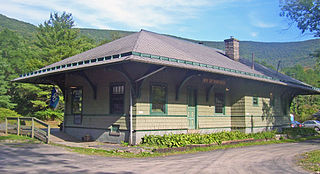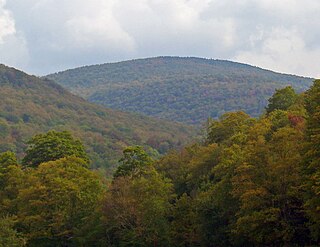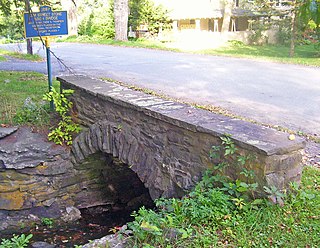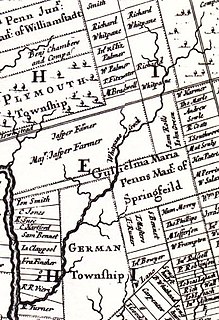
Tannersville is a village in Greene County, New York, United States. The village is in the north-central part of the town of Hunter on Route 23A. The population was 539 at the 2010 census, up from 448 at the 2000 census.

Waterville is a village in Oneida County, New York, United States. According to the 2010 census, its population was 1,583.

Burlington is a census-designated place (CDP) in Mineral County, West Virginia located along U.S. Route 50 where it crosses Pattersons Creek. As of the 2010 census, its population was 182. It is part of the Cumberland, MD-WV Metropolitan Statistical Area. The ZIP code for Burlington is 26710.

Phoenicia station is a disused train station located on High Street just south of Phoenicia, New York, United States. It is a frame building dating to the end of the 19th century.

Hanes and Hanes Her Way is a brand of clothing.

The Rondout–West Strand Historic District is located on the shore of Rondout Creek along the southern boundary of the city of Kingston, New York, United States. Formerly Rondout, New York, it is bounded by the creek, Broadway, Hone, Ravine and McEntee streets, an area of 570 acres (2.3 km²) containing 259 buildings, most dating to the 19th century. US 9W and the John T. Loughran Bridge are immediately to the east; the Kingston-Port Ewen Suspension Bridge crosses the creek to the west. The neighborhood is often referred to locally by either of the two names.

Balsam Lake Mountain is one of the Catskill Mountains, located in the Town of Hardenburgh, New York, United States. It is the westernmost of the range's 35 High Peaks. Its exact height has not been determined, but the highest contour line on topographic maps, 3,720 feet (1,130 m), is usually given as its elevation.

The Benjamin DuBois Stone House, also known as the Captain Martin Stone House is located at 347 West Main Street, Catskill, New York, on the west side of Catskill Creek. It is significant for its architecture and historically for its relation to the settlement of the area. The Dubois family were some of the original white settlers of the town. The house was built in the 1740s. After passing out of the DuBois family, it was owned by Captain Martin, who made extensive renovations to the house in the mid nineteenth century. It was added to the National Register of Historic Places in 1995. It differs from the DuBois Stone House, though they are both listed at the same address on their National Register of Historic Places nomination forms. The pictures attached to the two forms are of different structures.

The DuBois Stone House is located at 347 West Main Street, in Catskill, New York, on the west side of Catskill Creek. It was built in 1762 by Huybartus DuBois and Cornelius DuBois, sons of Benjamin DuBois, one of the original white settlers of the area. It is significant for its late 18th-century architecture and as the home of Huybartus DuBois and his family. After passing out of the DuBois family, the house was owned by the Washburn Brick Company, and the Union Free School District Number 1. In the 1940s it was used as a classroom for Home Economics. Later, it was used as administrative offices. The house was added to the National Register of Historic Places in 1995. In 2008, it is again a private residence.

The Wiley Hose Company Building is located in Catskill, New York. The three story, brick building is a representative example of a turn-of-the-century firehouse. It was built in 1900 by George W. Holdridge, a local builder. The brick was produced in the Catskill area, and is complemented by stone and terra cotta detailing. The firehouse was altered somewhat around 1930 to accommodate the newer, larger mechanized fire equipment that replaced horse-drawn and smaller mechanized equipment. The matching entry porticos on either side were added at this time, and the wooden flooring in the equipment bay was replaced with concrete.

King Philip Mills is an historic cotton mill complex located at 372 Kilburn Street in Fall River, Massachusetts. Developed between 1871 and 1892, it was historically one of the city's largest mills, and its building inventory is still largely complete. The complex was added to the National Register of Historic Places in 1983.

The Elizabeth Boit House is a historic house at 127 Chestnut Street in Wakefield, Massachusetts.

The Abell-Kilbourne House in Martinsburg, West Virginia is associated with John N. Abell, a prominent Martinsburg businessman and Charles W. Kilbourn, a Martinsburg mill owner. The former president of the Old National Bank, Abell developed the area known as "Abell's Addition" after his retirement in 1886. At that time Abell lived at 506 West Burke Street.

The Elm Street Stone Arch Bridge is located along that street in Pine Hill, New York, United States. It is a short bridge built over Alton Creek in the early 20th century using stonemasonry techniques and an arch bridge design that had been employed in the Catskills since the 18th century, one. As one of the few extant and intact bridges in that style in the region, it was listed on the National Register of Historic Places in 1996 along with the nearby Mill Street Stone Arch Bridge. It is located in the Pine Hill Historic District.

The Balsam Lake Mountain Fire Observation Station is located at the summit of the mountain of that name in the Town of Hardenburgh, New York, United States. It comprises a steel frame fire lookout tower, the observer's cabin and privy and the jeep road to the complex.

Greene Mansion is a historic home located at 92 Market Street in Amsterdam, Montgomery County, New York. It was built in 1881 as a residence for Henry Eckford Greene, who died two months after it was completed and never lived in it. Henry Greene was one of two sons of William Kimball Greene, who founded the Greene Knitting Mills, the first carpet factory in Amsterdam. The Greene family built a number of beautiful houses on Market Street, of which the Greene Mansion is one.

Mull & Fromer was a United States construction company based in Catskill, New York.
Frederick Hamilton Gouge was an American architect practicing in Utica, New York.

The Hilgen and Wittenberg Woolen Mill is a former woolen mill located in Cedarburg, Wisconsin, United States. In 1864, in response to the demands of the U.S Civil War Frederick Hilgen, Diedrich Wittenberg, and Joseph Trottman planned to build a woolen mill to provide textile goods for the war effort. In 1865 and at a cost of $30,000 the mill was completed, the complex consisted of two limestone buildings outfitted with state of the art equipment coupled to turbines powered by Cedar Creek. While completed too late to produce goods for the U.S Civil War the mill would be very successful and go on to produce blankets, and flannels.

Spring Mill is a small unincorporated community in Whitemarsh Township, Montgomery County, Pennsylvania.



















